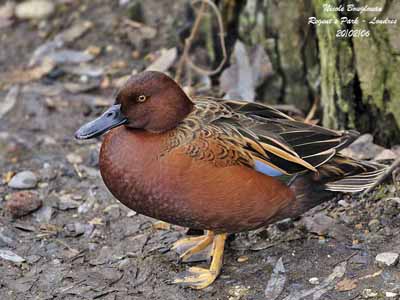
Cinnamon Teal – Anas cyanoptera
Anseriforme Order – Anatidae Family
BIOMETRICS:
Length: 36-43cm; Weight: 280 to 500 g
LONGEVITY: 12 years
DESCRIPTION:
Cinnamon Teal male breeding plumage has bright cinnamon head and body plumage. Rump, tail and undertail coverts are dark. We can see a light blue patch on upperwing with white rear border. Back of wings is iridescent green.
Eyes are red. Bill is black and large. Legs and feet are yellowish.

Female is grey-brown, and we can see a small white area at base of dark bill. She has light blue wing patch, bordered with white. She has greyish bill and brown eyes.
Male in basic plumage is similar to adult female, but it has red eyes and brighter forewing.
Immature is similar to adult female.
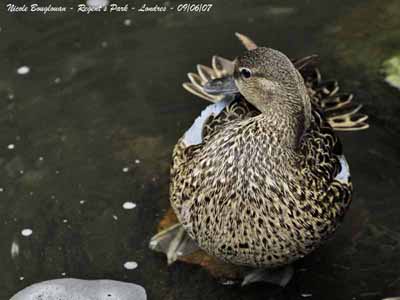
VOICE:
Cinnamon Teal female gives loud quacks, and male utters series of “chuck” notes.

HABITAT:
Cinnamon Teal is common in marshes, ponds and lakes. It uses freshwater and also highly alkaline waters. It prefers shallow water bordered by low grassy growth.
RANGE:
Cinnamon Teal breeds from southern Canada, southwards to central Mexico, eastwards to western Nebraska. It is found also in South America.
It winters from southern Texas and California, southwards to Central America, and also in South America.
BEHAVIOUR:
Cinnamon Teal feeds on surface, in shallow water. It also dives for food, for aquatic plants or arthropods from the bottom-aquatic bed. It feeds also on the ground, eating flowers and fruits.
Cinnamon Teal lives often in small flocks, including pairs. They migrate in flocks of up to 20 birds. They are aquatic ducks, but they are able to walk or run on land.
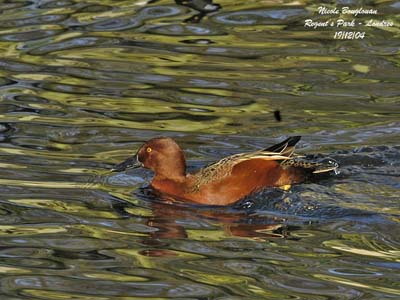
Cinnamon pairs sleep and roost together, very close to each other, at about one metre. Female sleeps while male remains alert. They sleep on water or dry areas near water. In spring, they spend the day sleeping, loafing, preening, swimming, walking or flying.
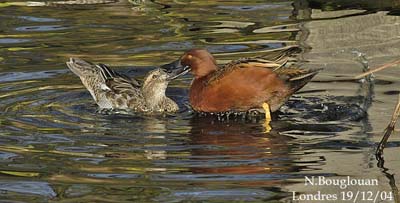
Male is territorial and protects its mate and nest site. Dominance hierarchies occur.
Cinnamon Teals renew pairs bonds during winter. Female swims in front of the male. Male performs some displays to attract female, such as “preen-behind-wing”, and “preen dorsally”, “belly-preen”, “preen-back-behind-wing”, repeated calls, turning back of head, and head-dip. They may perform flight displays if there are several males for one female.
Then, male and female, swim towards one another, bobbing their heads, and copulation occurs on water surface, male grasping female neck with its bill while they copulate. After copulation, both adults bathe and preen (Gammonley-1996).
Cinnamon Teal female is very protective of the nest. If an intruder is nearly, she attacks it away from the nest, performing a disturbance, feigning injury before flying away. Male protects nest site from predators, but it circles the area, rather than protect the nest.
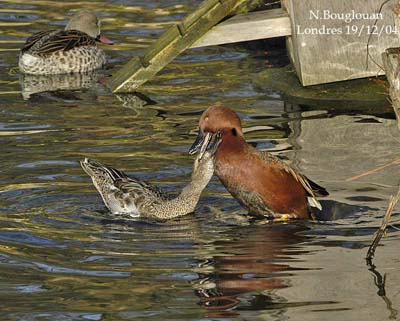
FLIGHT:
Cinnamon Teal has very agile flight. It may make sudden turns while is flying low, and it can take off directly from water.
REPRODUCTION:
Cinnamon Teal’s nest is built by female. It is a half-moon shaped nest, made with stems and dead grasses, and some down. Nest is situated on the ground, among vegetation near water.
Female lays 8 to 12 creamy white eggs. Incubation lasts about 21 to 25 days. Chicks leave the nest at about one day after hatching. They follow the female to the water, and hide by diving or seeking vegetation cover. They feed themselves from the first day, but they remain with female until they fledge, at about seven weeks of age. Then, they range farther from nest and female. They reach their sexual maturity at one year.
This species produces only one brood per season.
DIET:
Cinnamon Teal feeds on aquatic and emergent plants, seeds, insects and molluscs.
Cinnamon Teal has many predators such as mammals (cats, dogs, foxes and raccoons), and crows, ravens, gulls and magpies.
Cinnamon Teal is victim of brood parasitism by other duck species, but it is also of other ducks itself.
Populations are declining, due to draining wetlands for cultivation and diverting water for irrigation.
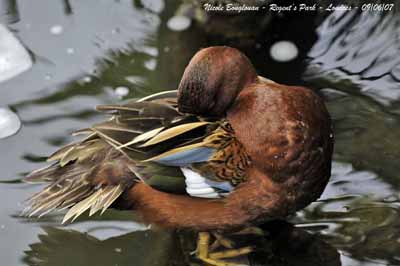
Fr: Sarcelle cannelle
All : Zimtente
Esp : Cerceta Colorada
Ital : Anatra color cannella
Nd : Kaneeltaling
Sd : Kanelarta
Text and photographs by Nicole Bouglouan
Sources:
GUIDE DES CANARDS, DES OIES ET DES CYGNES – de Steve Madge - Delachaux et Niestlé - ISBN: 2603013769
All About Birds - Cornell Lab of Ornithology
Animal Diversity Web - (University of Michigan Museum of Zoology)
Bird Web (Seattle Audubon Society)
SORA Searchable Ornithological Research Archive (Blair O. Wolf)
What Bird-The ultimate Bird Guide (Mitchell Waite)
Wikipedia (Wikipedia, The Free Encyclopedia)